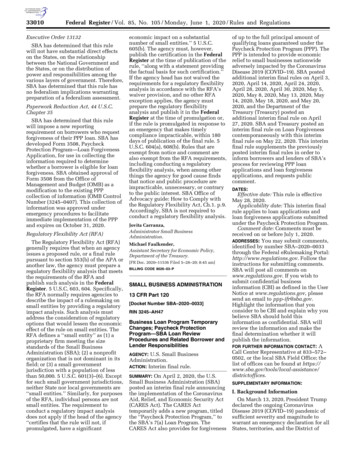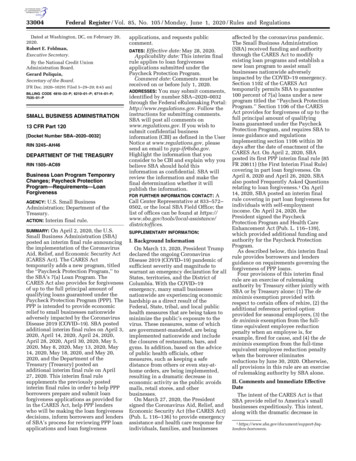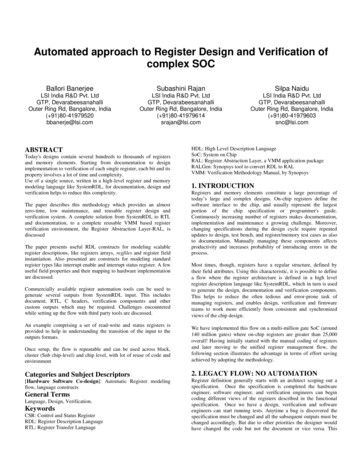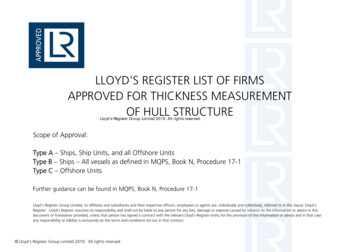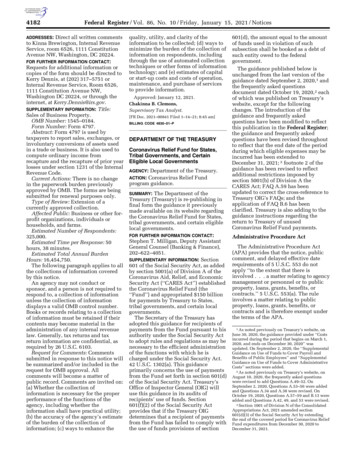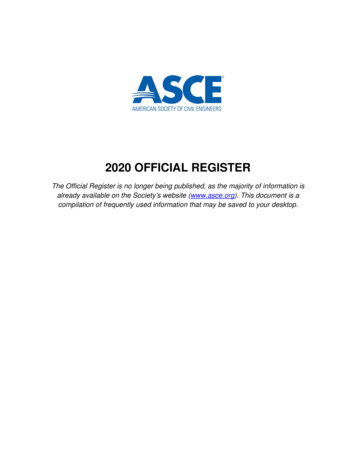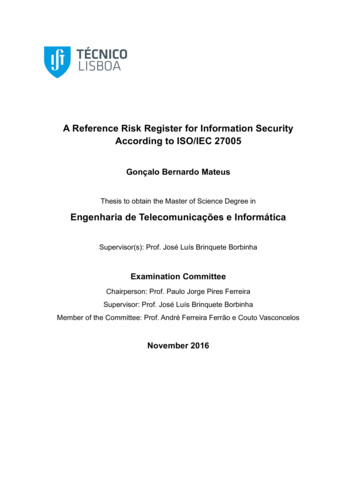
Transcription
A Reference Risk Register for Information SecurityAccording to ISO/IEC 27005Gonçalo Bernardo MateusThesis to obtain the Master of Science Degree inEngenharia de Telecomunicações e InformáticaSupervisor(s): Prof. José Luís Brinquete BorbinhaExamination CommitteeChairperson: Prof. Paulo Jorge Pires FerreiraSupervisor: Prof. José Luís Brinquete BorbinhaMember of the Committee: Prof. André Ferreira Ferrão e Couto VasconcelosNovember 2016
ii
AcknowledgmentsI would like to thank Professor José Borbinha and Ricardo Vieira for the amazing support during thisproject. Without their help, I believe I wouldn’t have finished it.I would also like to thank my friends and coworkers at Muzzley.Ultimately, I would like to dedicate the work done to my friends and family. A very special thank you tomy parents, João and Anabela, to my brother Hugo and to my grandparents and uncles. I would alsolike to thank Elisa Simion, for the great support on these last few months.iii
iv
ResumoNos dias de hoje, uma das maiores preocupações é garantir que a informação é mantida emsegurança, sem colocar os ativos de organizações em risco. A gestão de risco tornou-se umaatividade essencial, permitindo organizações avaliarem os riscos e identificar os devidosprocedimentos para a sua mitigação. Apesar da existência de um corpo consolidado deconhecimento, as organizações e os gestores de risco, em particular, ainda lutam para identificar omodelo de gestão de risco em segurança de informação mais adequado que deve ser usado noprocesso de gestão de riscos. O objectivo do presente documento é analisar o corpo deconhecimento de segurança de informação, a fim de estabelecer um modelo de gestão de risco emsegurança de informação de referência. Este modelo proposto será aplicado no caso de umaorganização real, seguindo um processo proposto, terminando com o desenvolvimento de um registode riscos de referência, que mais organizações podem potencialmente usar para registar informaçõesnum processo de gestão de riscos em segurança de informação.Palavras-Chave: Risco, Mitigar, Gestão, Informação, Registo, Segurança.v
AbstractNowadays, one of the biggest concerns is to ensure that information is kept secure, without putting atrisk organization’s assets. Risk management has become an essential activity, allowing organizationsto assess risks and identify procedures to mitigate risks. Despite the existence of a consolidated bodyof knowledge, organizations and risk managers in particular still struggle to identify the most suitableinformation security risk management model that should be used in the risk management process. Thepurpose of this document to analyse the information security body of knowledge in order to establish areference information security risk management model. This proposed model will be applied on a reallife organization, following a proposed process, ending with the development of a reference riskregister, which more organizations can potentially use to record information in a information securityrisk management process.Keywords: Risk, Mitigate, Management, Information, Register, Security.vi
Table of ContentsAcknowledgments .iiiResumo .vAbstract .viTable of Contents .viiList of Figures .ixList of Tables .xiList of Acronyms .xiii1.2.Introduction .11.1.Information Security .11.2.Risk Management .21.3.Research Problem and Proposed Solution .21.4.Research Methodology .31.5.Document Structure .4Related Work .52.1.Risk Management Fundamentals .52.2.Information Security Fundamentals .82.3.3.2.2.1.ISO/IEC 27005 .92.2.2.COBIT .122.2.3.OCTAVE .122.2.4.NIST .132.2.5.FAIR .14ISSRM .15Problem Analysis .193.1.Analysis of ISRM References .193.2.Analysis of the Core Domain Model Concepts .213.2.1.Asset .213.2.2.Threat .213.2.3.Vulnerability .223.2.4.Control .223.2.5.Risk .233.2.6.Event .23vii
4.5.3.2.7.Consequence .243.2.8.Impact .24Application .264.1.Domain Model Proposal .264.2.Case Study .274.3.Process Description .284.3.1.Integrate the information .294.3.2.Structure the information .304.3.3.Complement the information .33Conclusions and Future Work .375.1.Conclusions .375.2.Lessons .375.3.Future Work .38References .39Appendixes .40Appendix A – Translation of Portuguese terms to English .40Appendix B – Sample of Case Study’s consolidated risk register .41Appendix C – Sample of first risk register after analysis of the Case Study’s risks .43Appendix D – Events extracted from Case Study’s consolidated risk register .45Appendix E – Controls extracted from Case Study’s consolidated risk register .46Appendix F – Consequences extracted from Case Study’s consolidated risk register .47Appendix G – Asset list from ISO/IEC 27005 .47Appendix H – Threat list from ISO/IEC 27005 .48Appendix I – Vulnerabilities list from ISO/IEC 27005 .49Appendix J – Sample of last proposed risk register .50Appendix K – Sample of final version of risk register sent by the Case Study .54viii
List of FiguresFigure 1 – Methodology used to build the proposed solution .3Figure 2 – Relationships between risk management principles, framework and process [3] .6Figure 3 – Risk management process [3] .7Figure 4 – Information security risk management process [7] . 11Figure 5 – How FAIR works with ISO/IEC 27005 [1] .15Figure 6 – ISSRM meta-model .15Figure 7 – Domain model proposal .27Figure 8 – Process of using a reference risk register inside an organization .28Figure 9 – Structure of the Case Study’s risk registers .29Figure 10 – Sample of the consolidated Case Study’s risk register .30Figure 11 – Risk examples retrieved from the consolidated risk register .30Figure 12 – Partial sample of the initial analysis made on the Case Study’s risks .31Figure 13 – Sample of event list retrieved from the Case Study risk information .32Figure 14 – Sample of ISO/IEC 27005 list of retrieved assets .32Figure 15 – Sample of ISO/IEC 27005 list of retrieved vulnerabilities .33Figure 16 – Sample of ISO/IEC 27005 list of retrieved threats .33Figure 17 – Screenshot of the Holirisk tool showing part of Case Study’s asset list .34Figure 18 – Screenshot of the Holirisk tool showing the Case Study’s event list .35Figure 19 – Screenshot of the Holirisk tool showing the Case Study’s risk list .35Figure 20 – Screenshot of the Holirisk tool showing the Case Study’s consequence list .36ix
x
List of TablesTable 1 – Relevant techniques for risk assessment [4] .7Table 2 – Asset definition according to the various references analysed .21Table 3 – Threat definition according to the various references analysed .21Table 4 – Vulnerability definition according to the various references analysed .22Table 5 – Control definition according to the various references analysed .22Table 6 – Risk definition according to the various references analysed .23Table 7 – Event definition according to the various references anal
Risk management allows the assessment of threats to information and consequently assures that those threats are controlled. When the subject is information security, ISO/IEC 27001 [8] is one of the most known references and defines the requirements for “establishing, implementing, maintain and continually improving an information security management system” [8]. within the context of the .File Size: 2MBPage Count: 71



